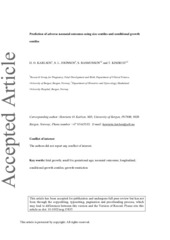Prediction of adverse perinatal outcome of small-forgestational- age pregnancy using size centiles and conditional growth centiles
Peer reviewed, Journal article
Accepted version

View/
Date
2016-08Metadata
Show full item recordCollections
Original version
https://doi.org/10.1002/uog.15835Abstract
Objective: To test whether adding conditional growth centiles to size centiles of estimated fetal weight (EFW) improves prediction of adverse perinatal outcome in pregnancies with or at risk of having a small-for-gestational-age (SGA) fetus. Methods: This prospective longitudinal study included pregnant women at risk of or diagnosed with an SGA (≤ 5th centile) fetus. They underwent serial ultrasound measurements and the final two were included in the analyses for this study. The EFW was categorized into normal (> 5th or 10th centile) and abnormal (≤ 5th or 10th centile) for size and conditional growth before entering the variables into log-binomial regression analyses. Adverse outcomes were delivery < 37 weeks, operative delivery due to fetal distress, 5-min Apgar score < 7, newborn hypoglycemia (glucose < 2.0 mmol/L), admission to the neonatal intensive care unit and perinatal mortality. A combined outcome variable (‘any adverse outcome’) included one or more adverse outcomes. Results: Complete biometric data were obtained for 211 women. Conditional growth and size centiles contributed independently to the prediction of adverse outcome. Combining conditional growth and size centiles significantly improved the prediction of outcomes compared with size centiles alone (e.g. for 5th centile cut-off for any adverse outcome, P = 0.023, log-likelihood test). Using a 5th centile threshold, for any adverse outcome, the specificity of 78% (95% CI, 70–84%) using size centile as a predictor was improved to 94% (95% CI, 89–97%) when conditional growth centile was added to the model, whereas the sensitivity was not significantly changed (60% (95% CI, 49–69%) vs 39% (95% CI, 30–50%)). Conclusions: Size centiles and conditional growth centiles contribute independently to the prediction of adverse perinatal outcome, and their combination further improves the prediction model. The results support an increased use of conditional growth centiles in the monitoring of fetuses at risk.